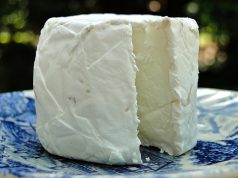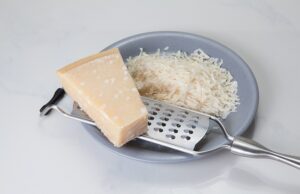Contents
Master the Art of Grating Cheese with These Simple Tips
If you’re a cheese lover, then you probably know how important it is to have freshly grated cheese on top of your dishes. Whether it’s for pizzas, salads, or pasta, grated cheese enhances the taste and texture of any meal.
But let’s face it, grating cheese can be a bit of a hassle. Cheese can be sticky, greasy, and hard to handle. Plus, there’s always the risk of injuring your fingers if you’re not careful. But fear not! With a few simple tips, you can master the art of grating cheese and take your dishes to the next level.
- Choose the right type of grater: There are different types of graters available, each suited for a specific type of cheese. A box grater is perfect for soft to semi-hard cheeses like cheddar, while a microplane grater is ideal for hard cheeses like Parmesan.
- Use cold cheese: Warm cheese can melt and stick to the grater, making it difficult to shred. So, it’s always best to keep your cheese in the fridge until you’re ready to grate it.
- Grate in the right direction: Always grate in a downward motion, and avoid grating in a back-and-forth motion, as this can result in uneven shreds.
- Clean your grater properly: Cheese can be sticky and difficult to remove from the grater, so make sure to clean it thoroughly after each use. Use a brush or a sponge to remove any cheese particles, and rinse it with hot water.
By following these simple tips, you’ll be grating cheese like a pro in no time. So, go ahead and add some freshly grated cheese to your next meal, and take your taste buds on a delicious journey!
Why Grating Cheese is Important?
Cheese is a staple ingredient in many dishes, and grating it properly can greatly enhance the flavor and texture of your meals. Grated cheese can be used as toppings for pasta, salads, pizzas, and sandwiches, and it can also be mixed into sauces and dips for added richness and creaminess.
Types of Cheese That Can Be Grated
Hard Cheeses
Hard cheeses such as Parmigiano-Reggiano, Pecorino Romano, and Asiago can be grated finely and used as a finishing touch to pasta dishes, risottos, and salads.
Semi-Hard Cheeses
Semi-hard cheeses like Cheddar, Gouda, and Monterey Jack can be grated coarsely and used as toppings for burgers, sandwiches, and burritos.
Soft Cheeses
Soft cheeses like Brie, Camembert, and Goat cheese can be crumbled or grated and used as fillings for omelets, quiches, and pizzas.
Tools for Grating Cheese
There are several types of cheese graters that can be used to grate cheese, including box graters, handheld graters, and rotary graters. Each type of grater has its own unique benefits and drawbacks, but all can be effective in producing grated cheese.
Tips for Grating Cheese
Use Cold Cheese
Cold cheese is easier to grate than warm cheese as it can hold its shape and provide greater control when grating. Place the cheese in the refrigerator for at least 30 minutes before grating to ensure it is chilled.
Choose the Right Grater
The type of grater you use can greatly impact the texture of the grated cheese. For finer shreds, use a handheld grater or Microplane; for coarser grating, use a box grater or rotary grater.
Grate Against the Grain
When grating cheese, grate against the grain to produce long and even shreds. This will not only improve the texture of the cheese but also make it easier to sprinkle or spread on your dishes.
Clean the Grater Regularly
Clean your cheese grater regularly to avoid the buildup of cheese residue and prevent clogging. Use a stiff brush or a toothbrush to scrub the grater and rinse it with warm water and soap.
Conclusion
Grating cheese may seem like a simple task, but it can greatly impact the taste and appearance of your dishes. By choosing the right type of cheese, grater, and following these simple tips, you can master the art of grating cheese and take your meals to the next level.
References:
- Food Network: How to Grate Cheese
- The Spruce Eats: How to Grate Cheese Perfectly Every Time
- Epicurious: How to Use Different Types of Cheese Graters
Frequently Asked Questions
What are some simple tips for grating cheese?
Some simple tips for grating cheese are:
- Grate the cheese when it is cold to prevent it from becoming too soft.
- Use a sharp grater to make the process easier.
- Apply light pressure when grating to prevent the cheese from becoming too fine or turning into a paste.
- Grate the cheese in long strokes instead of short, choppy ones.
- Grate the cheese directly over the food instead of grated ahead of time to prevent it from drying out.
What types of cheese can be grated?
Most types of cheese can be grated, but some of the most common are:
- Cheddar
- Parmesan
- Monterey Jack
- Mozzarella
- Colby
- Swiss
Can a food processor be used to grate cheese?
Yes, a food processor can be used to grate cheese. However, it is important to remember not to over-process the cheese, as it can result in a powdery or clumpy consistency.
How much cheese should be grated for a recipe?
The amount of cheese needed for a recipe will vary, but a general rule of thumb is to grate about 1/4 to 1/2 cup of cheese per person. It is always better to grate more than less, as extra cheese can always be added to the finished dish.
The Easiest Way to Grate Cheese
Why You Need to Know the Easiest Way to Grate Cheese
Cheese is a favorite ingredient in many dishes, but grating cheese can sometimes be a daunting task. Whether you’re making a pizza, a salad, or macaroni and cheese, knowing the easiest way to grate cheese can save you time and effort. In this article, we’ll show you some tips and tricks to make cheese grating a breeze.
The Tools You Need to Grate Cheese
To grate cheese easily, you’ll need the right tools. The most common tools for grating cheese are:
- A box grater
- A rotary grater
- An electric grater
Each tool has its pros and cons, but the box grater is the easiest to use for most people. It’s also the most affordable and takes up the least space in your kitchen. Choose a box grater with different sized grating holes, so you can grate cheese in different textures and sizes.
The Steps to Grate Cheese with a Box Grater
Here’s how to grate cheese with a box grater:
- Wash and dry the cheese and the grater.
- Choose the grating size based on what you need for your dish.
- Hold the grater over a bowl or a plate and rub the cheese against the grater’s holes, using a downward motion.
- Rotate the cheese as you grate, so you can use all sides of the cheese.
- When you get close to the end of the cheese, use a fork to hold it steady and avoid grating your fingers.
- Collect the grated cheese from the plate or the bowl and use it for your dish.
Conclusion
Grating cheese doesn’t have to be a chore. With the right tools and a few tips, you can grate cheese easily and quickly. Remember to choose the right grater for your needs and take precautions to avoid grating your fingers. By following these steps, you’ll be able to add delicious grated cheese to all your favorite dishes.
For more information about different types of cheese, visit Wikipedia’s article on cheese.
Master the Art of Grating Cheese with These Simple Tips
Grating Cheese: A Basic Technique
- Choose the right grater for the type of cheese
- Cut cheese into small chunks to make it easier to grate
- Use a light, vertical motion to grate the cheese
- Grate just enough cheese for the recipe to avoid waste
Special Tips for Grating Hard Cheeses
- Freeze the cheese for 10-15 minutes before grating for easier handling
- Grate the cheese at room temperature for better flavor distribution
- Clean the grater immediately after use to avoid hard-to-remove cheese bits
Tips for Grating Soft Cheeses
- Use a microplane or fine grater for soft cheeses like Parmesan or Pecorino
- Chill the cheese in the fridge for 20-30 minutes before grating
- Sprinkle flour or cornstarch on the cheese to prevent clumping







































